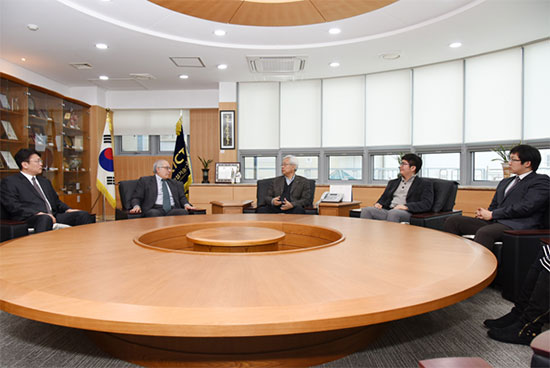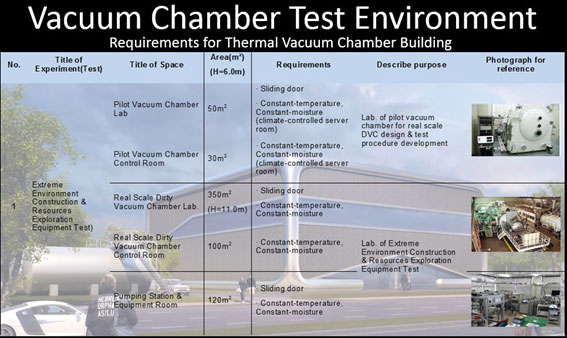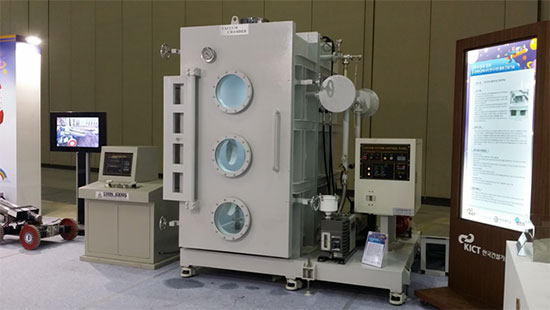KICT to participate in a NASA training program with space environment simulation technology
Korea’s space construction technologies will join hands with NASA to create a space environment that simulates actual lunar caves and thus provide young students and researchers around the world first-hand experience of various phenomena of lunar sites and space construction technologies. This was recently learned from the Korean Institute of Civil Engineering and Building Construction (KICT).

KICT headed by President Dr. Tai-Sik Lee announced on Jan. 23, 2017 that the Institute will participate in the “Lunar Caves Analog Test Sites (LCATS)” space-STEM education program funded by NASA. KICT will offer its research facilities, including the “Dirty” Vacuum Chamber, which is currently under construction, as well as various lunar resources and other space construction technologies.
Sam Ximenes, Board Chair of the WEX Foundation and Principal Investigator for the LCATS program, visited KICT in Ilsan, South Korea, on Dec. 28, 2016, and offered his appreciation for KICT’s participation in the LCAST program and discussed detailed plans.

KICT and the International Space Exploration Research Institute (ISERI) at Hanyang University, along with WEX Foundation (Principal Investigator), received a grant from NASA in early 2016 to develop a Space-STEM education program. Totaling an equivalent 1.48 billion KRW (1.24 million USD), this large-scale funding project allows KICT and Hanyang University to develop space educational contents for both Korean students and young students from around the world using their lunar research infrastructure, resources, and technologies (LEAP2 and LCATS).

LEAP2 (Lunar Ecosystem and Architectural Prototype): An international collaborative research project that researches space construction technologies for the settlement of the human race in “Marius Hills Skylight,” a lava cave region naturally created on the Moon.
LCATS (Lunar Caves Analog Test Sites): A plan to create a simulated site on Earth, similar to the lava caves and the lunar surfaces, and use it as a research test-bed for LEAP2
The program co-joined by KICT and Hanyang University is a STEM (Science, Technology, Engineering, and Mathematics) education network, one of NASA’s core educational programs. KICT plans to share its infrastructure and human resources with NASA in future in order to offer Korean and US research and educational staff and students a unique educational program using its large vacuum chamber, which allows for the simulation of lunar soil environments.

The STEM educational network is a platform through which space educational contents are developed and offered to students globally. Besides the US and Korea, the education network establishes a collaborative research consortium also participated in by Germany and Mexico. Dubai in the United Arab Emirates is another potential partner.

KICT plans to complete its full scale vacuum chamber by the end of 2017. It is designed to realize testing environments at ultralow temperatures and close to a vacuum state as well as those similar to lunar surfaces using artificial simulants. Through its full scale extreme environment testing infrastructure, KICT will fully engage in LEAP2 and LCATS projects.
KICT and Hanyang University, based on their state-of-the-art vacuum chamber, research resources and equipment, as well as other space construction technologies, are planning to develop an educational program that allows global students and research staff to experience various phenomena on the Moon and space construction technologies.

Sam Ximenes, Board Chair of the WEX Foundation said, "The addition of KICT and Hanyang University (ISERI) to the NASA program gives Korean and US students the opportunity to experience a new educational program, and KICT will make a huge contribution to helping them develop their future dreams for the space."
KICT and Hanyang University have established the research agenda and have been conducting corresponding research projects that can help the two research institutes lead the current domestic and global space construction research.

